american
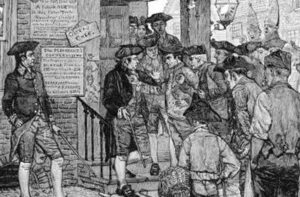
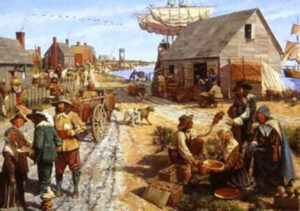 If you travel to a different area of the country or even other English-speaking areas of the world, you will find that here are different accents and even that words are used differently. Still, just because you are visiting or move to those places, doesn’t mean that you will immediately take on those accents, or their use of words. Nevertheless, when you move to a different region, your use of the language does immediately begin to evolve, whether you realize it or not, and whether it is intentional or not. The first Englishmen to set foot on American soil with the intent to colonize the land were no exception. The language began to evolve almost immediately….and it remains a fluid, almost living process to this day. “Americanisms” have been created or changed from other English terms to produce a language that very much differs from our forefathers, signifying our uniqueness and independence.
If you travel to a different area of the country or even other English-speaking areas of the world, you will find that here are different accents and even that words are used differently. Still, just because you are visiting or move to those places, doesn’t mean that you will immediately take on those accents, or their use of words. Nevertheless, when you move to a different region, your use of the language does immediately begin to evolve, whether you realize it or not, and whether it is intentional or not. The first Englishmen to set foot on American soil with the intent to colonize the land were no exception. The language began to evolve almost immediately….and it remains a fluid, almost living process to this day. “Americanisms” have been created or changed from other English terms to produce a language that very much differs from our forefathers, signifying our uniqueness and independence.
Of course, the people didn’t notice the changes right away, but by 1720, the English colonists began to notice that their language was quite different from that spoken in their Motherland. I’m sure they wondered just how that came to be? Basically, when you hear new “slang” words, and people don’t hear the accents spoken as well, the whole dynamic of the language changes. Also, very formal words like “thee, thou, and such” might become too cumbersome and so they are discarded. Everyone in the colonies knew that English would be our native language by 1790, because when the United States took its first census, there were four million Americans, 90% of whom were descendants of English colonists. So, it made perfect sense.
Nevertheless, it would not be the same as that spoken in Great Britain. The reasons are varied, but the most obvious reason was the sheer distance from England. The main way the language evolved was that over the years, many words were borrowed from the Native Americans, as well as other immigrants from France, Germany, Spain, and other countries. In addition, words that became obsolete “across the pond” continued to be utilized in the colonies. In other cases, words simply had to be created in order to explain the unfamiliar landscape, weather, animals, plants, and living conditions that these early pioneers encountered. By 1790 it was obvious that American English would be a very different language that British English.
The first “official” reference to the “American dialect” was made in 1756 by Samuel Johnson, a year after he published his Dictionary of the English Language. Johnson’s use of the term “American dialect” was not meant to simply explain the differences but rather, was intended as an insult. This “new” language was called “barbarous” and referred to our “Americanisms” as barbarisms. Because of the dissention between England and the Colonies, the British sneering at our language continued for more than a century after the Revolutionary War. They laughed and condemned as unnecessary, hundreds of American terms and phrases, but to our newly independent Americans, they were proud of their “new” American language and considered it to be another badge of independence. In 1789, Noah Webster wrote in his Dissertations on the English Language, “The reasons for American English being different than English English are simple…As an independent nation, our honor requires us to have a system of our own, in language as well as government.” In the eyes of the Colonists, that settled the matter, and when the United States was formed, the new nation was proud to be separated for the “Motherland” and would have it no other way.
Our leaders, including Thomas Jefferson and Benjamin Rush, agreed — it was not only good politics, but it was also sensible. The most atrocious changes to the British were the heavy use of contractions such as ain’t, can’t, don’t, and couldn’t. The feelings of the “rest of the world” didn’t matter to Americans, and the language changed even more during the western movement as numerous Native American and Spanish words became an everyday part of our language. The evolution of the American language continued into the 20th century and really continues even to this day. After World War I, when Americans were in a patriotic and anti-foreign mood, the state of Illinois went so far as to pass an act making the official language of the state the “American language.” In 1923, in the State of Illinois General Assembly, they passed the act stating in part, “The official language of the State of Illinois shall be known hereafter as the ‘American’ language and not as the ‘English’ 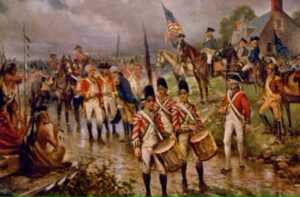
 language. A similar bill was also introduced in the US House of Representatives the same year but died in committee. Ironically, after centuries of forming our ‘own’ language, the English and American versions are once again beginning to blend as movies, songs, electronics, and global traveling bring the two ‘languages’ closer together.”
language. A similar bill was also introduced in the US House of Representatives the same year but died in committee. Ironically, after centuries of forming our ‘own’ language, the English and American versions are once again beginning to blend as movies, songs, electronics, and global traveling bring the two ‘languages’ closer together.”
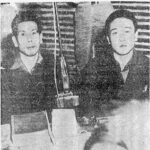
 When a soldier is told to guard an area for his country, he does just that, but on this occasion, this job of “guarding” an area, or an island in this case, was taken to extremes. For a time, the Allies struggled against the Japanese, but by 1945, the tide of World War II had turned decisively against Japan. The Japanese got really nervous as the Americans advanced across the Pacific, drawing ever closer to the Japanese home islands. The American strategists set their sights on Iwo Jima, a small volcanic island about 750 miles south of Tokyo. They saw it as a suitable staging area for an eventual invasion of Japan. Of course, the Japanese were very aware of the threat posed by Iwo Jima landing in American hands. So, they knew they had to garrison the island.
When a soldier is told to guard an area for his country, he does just that, but on this occasion, this job of “guarding” an area, or an island in this case, was taken to extremes. For a time, the Allies struggled against the Japanese, but by 1945, the tide of World War II had turned decisively against Japan. The Japanese got really nervous as the Americans advanced across the Pacific, drawing ever closer to the Japanese home islands. The American strategists set their sights on Iwo Jima, a small volcanic island about 750 miles south of Tokyo. They saw it as a suitable staging area for an eventual invasion of Japan. Of course, the Japanese were very aware of the threat posed by Iwo Jima landing in American hands. So, they knew they had to garrison the island.
Ymakage Kufuku and Matsudo Linsoki were two Japanese machine gunners assigned to the island’s garrison. I can only imagine how they must have felt, knowing that the attack was imminent, and that they could only sit and wait for it. In February of 1945, Iwo Jima was invaded in one of the fiercest and bloodiest battles of the entire Pacific War. The Japanese soldiers fought frantically, almost to the last man. Japanese soldiers were taught that it was more honorable to die that survive, if they lost the war. They were taught that rather than surrender, the honorable thing to do was to commit suicide, so out of a garrison of 21,000 Japanese, nearly 20,000 died before the island was declared secured.
Kufuku and Linsoki were among the few Japanese soldiers who didn’t die in the fighting and didn’t commit suicide. They also believing what their government told them about Americans torturing and killing prisoners, so they were too afraid to surrender. The two men felt like they had no choice but to go underground. They also expected that soon the Japanese would be able to take the island back, so they hid during the day in the multitude of tunnels that were all over the island. They came out at night pilfer food and other necessaries from the American garrison’s supply and trash dumps. It was a tough kind of life, but by doing this, Kufuku and Linsoki managed to survive for a long time in a barren and inhospitable island that was mighty short on both vegetation and game. The Americans weren’t interested in exploring Iwo Jima’s hard landscape, a fact that allowed the two Japanese soldiers to go unnoticed for years.
Finally, on January 6th, 1949, two US Air Force corporals in a Jeep spotted a couple of pedestrians in uniforms that looked to be a few sizes too big. The men were walking alongside a road. The soldiers thought the men were Chinese laborers. The men spoke no English and they didn’t seem to want to talk, but the American airmen just assumed they were hitchhiking to the island’s main base and gave them a lift. They dropped them off in front of the garrison’s headquarters building. That probably left Kufuku and Linsoki a little bit unnerved. Nevertheless, they didn’t want to seem suspicious, so they wandered around the American base for hours, at least until a passing American sergeant realized that they were Japanese and took them in. The men were 
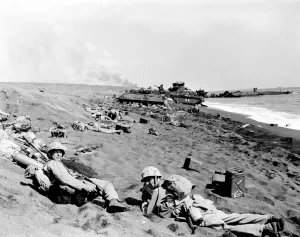 interrogated, and afterward, they took their captors to their hideout. There, to their amazement, the Americans found a cave richly stocked with canned foods, flashlights, batteries, uniforms, boots, shoes, socks, and other goods that the pair had been pilfering over the years. I’m quite sure they recognized some of the items from the base. While the Japanese soldiers did no real harm, their self-imposed secret mission had come to an end.
interrogated, and afterward, they took their captors to their hideout. There, to their amazement, the Americans found a cave richly stocked with canned foods, flashlights, batteries, uniforms, boots, shoes, socks, and other goods that the pair had been pilfering over the years. I’m quite sure they recognized some of the items from the base. While the Japanese soldiers did no real harm, their self-imposed secret mission had come to an end.
 The Great Depression…while the main problem at that time in history was a lack of jobs and money, another huge problem was depression…real emotional depression. Of course, people just had to deal with that. There was nothing anyone could do about it…or was there? There was little that could be done about money, but maybe there was a way to lift everyone’s spirits and do some good too. So began the Depression Era Dance Marathons.
The Great Depression…while the main problem at that time in history was a lack of jobs and money, another huge problem was depression…real emotional depression. Of course, people just had to deal with that. There was nothing anyone could do about it…or was there? There was little that could be done about money, but maybe there was a way to lift everyone’s spirits and do some good too. So began the Depression Era Dance Marathons.
Dance Marathons (also called Walkathons) were an American phenomenon of the 1920s and 1930s. While they began as human endurance contests in which couples danced almost non-stop for hundreds of hours (as long as a month or two), competing for prize money, that couldn’t continue during the Great Depression years. Still, the dance marathons did continue throughout the 1930s as partially staged 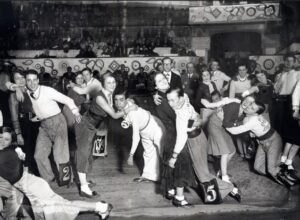 performance events that mirrored the marathons of the Roaring Twenties. In the dance endurance contests of the 20s, a mix of local hopefuls and seasoned professional marathoners danced, walked, shuffled, sprinted, and sometimes cracked under the pressure and exhaustion of round-the-clock motion. The Depression Era Dance Marathons weren’t exactly a means of keeping the American spirit up through the darkest financial crisis in its history, but rather they were human endurance contests that served as a way of giving broke married couples a roof over their head and food to eat for a few days.
performance events that mirrored the marathons of the Roaring Twenties. In the dance endurance contests of the 20s, a mix of local hopefuls and seasoned professional marathoners danced, walked, shuffled, sprinted, and sometimes cracked under the pressure and exhaustion of round-the-clock motion. The Depression Era Dance Marathons weren’t exactly a means of keeping the American spirit up through the darkest financial crisis in its history, but rather they were human endurance contests that served as a way of giving broke married couples a roof over their head and food to eat for a few days.
The real emphasis here is on the word contest. People had needs, and so they were highly motivated to win the contest. It was a good thing that these dancers were young people, because marathon dancing takes a lot of stamina. The couples would actually take 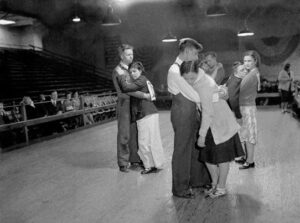 turns sleeping while their partner propped up and continued dancing with them. That kind of endurance was no easy feat, but in the end, it was all worth it…for the winners anyway. When you think about it, it while the marathons were a good idea, and the prizes really helped people out, it had to be exhausting, and it was definitely not for the older generation. You had to be young in body, in addition to being young at heart to endure all that. These couples danced their hearts out. Nevertheless, at some point, the couples finally gave out, until there was only one couple left, and the winners were announced. It was a contest of endurance. While they really needed the prize, I’m sure these couples had a great time too.
turns sleeping while their partner propped up and continued dancing with them. That kind of endurance was no easy feat, but in the end, it was all worth it…for the winners anyway. When you think about it, it while the marathons were a good idea, and the prizes really helped people out, it had to be exhausting, and it was definitely not for the older generation. You had to be young in body, in addition to being young at heart to endure all that. These couples danced their hearts out. Nevertheless, at some point, the couples finally gave out, until there was only one couple left, and the winners were announced. It was a contest of endurance. While they really needed the prize, I’m sure these couples had a great time too.
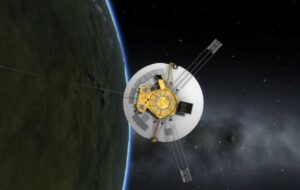
 Many of us have seen shows about a spacecraft that got lost in space and is seen wandering around trying to make their way back. Of course, those shows are fiction, but if you were going to explore beyond our galaxy, you would most likely need to send some sort of probe or spaceship out into the far reaches of space to see what it’s like out there. If the empty probe can’t function out there, it’s very likely not a good idea to send a manned spaceship out there. That is what Nasa figured anyway, and so in 1972, Pioneer 10…originally designated Pioneer F, was launched into space. Pioneer 10 is an American space probe, manufactured by TRW Inc. It isn’t overly heavy, weighing just 569 pounds. Its first mission to the planet Jupiter was completed with its closest approach happening on Dec 3, 1973. At that point, Pioneer 10 became the first of five artificial objects to achieve the escape velocity needed to leave the Solar System. At that point, it became part of a space exploration project that was conducted by the NASA Ames Research Center in California.
Many of us have seen shows about a spacecraft that got lost in space and is seen wandering around trying to make their way back. Of course, those shows are fiction, but if you were going to explore beyond our galaxy, you would most likely need to send some sort of probe or spaceship out into the far reaches of space to see what it’s like out there. If the empty probe can’t function out there, it’s very likely not a good idea to send a manned spaceship out there. That is what Nasa figured anyway, and so in 1972, Pioneer 10…originally designated Pioneer F, was launched into space. Pioneer 10 is an American space probe, manufactured by TRW Inc. It isn’t overly heavy, weighing just 569 pounds. Its first mission to the planet Jupiter was completed with its closest approach happening on Dec 3, 1973. At that point, Pioneer 10 became the first of five artificial objects to achieve the escape velocity needed to leave the Solar System. At that point, it became part of a space exploration project that was conducted by the NASA Ames Research Center in California.
“Pioneer 10 was assembled around a hexagonal bus with a 9-foot diameter parabolic dish high-gain antenna, and the spacecraft was spin stabilized around the axis of the antenna. Its electric power was supplied by four radioisotope thermoelectric generators that provided a combined 155 watts at launch. Pioneer was launched on March 2, 1972, by an Atlas-Centaur expendable vehicle from Cape Canaveral, Florida. Between July 15, 1972, and February 15, 1973, it became the first spacecraft to traverse the asteroid belt. Photography of Jupiter began November 6, 1973, at a range of 16,000,000 miles, and about 500 images were transmitted. The closest approach to the planet was on December 4, 1973, at a range of 82,178 miles. During the mission, the on-board instruments were used to study the asteroid belt, the environment around Jupiter, the solar wind, cosmic rays, and eventually the far reaches of the Solar System and heliosphere.”
I find it hard to believe that Nasa thought that the spacecraft would last as long as it did, but I suppose that the further out it went in space, the less it would encounter the kind of space debris that came from Earth. Still, there are meteors and planets, stars that it could be pulled into, and so many more things that could have meant the destruction if the craft. Nevertheless, Pioneer 10 continued to send out radio transmissions continued between Nasa and itself until January 23, 2003, and then only because of the loss of electric power for its radio transmitter. At that point, the probe was at a distance of 12 billion kilometers (7,456,454,306.848 miles) from Earth. 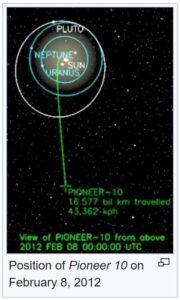
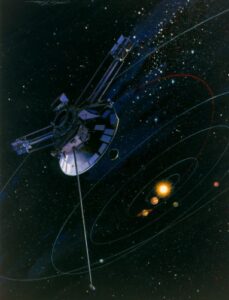
According to sources, “If left undisturbed, Pioneer 10 and its sister craft Pioneer 11 will join the two Voyager spacecraft and the New Horizons spacecraft in leaving the Solar System to wander the interstellar medium. The Pioneer 10 trajectory is expected to take it in the general direction of the star Aldebaran, currently located at a distance of about 68 light years. If Aldebaran had zero relative velocity, it would require more than two million years for the spacecraft to reach it. Well before that, in about 90,000 years, Pioneer 10 will pass about 0.23 parsecs (0.75 light-years) from the late K-type star HIP 117795. This is the closest stellar flyby in the next few million years of all the four Pioneer and Voyager spacecrafts, which are leaving the Solar System.”
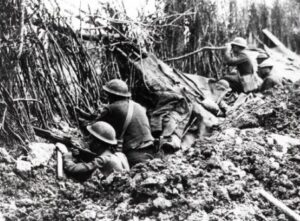
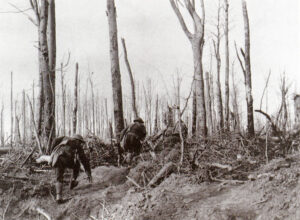 When I think of war and of the largest offensive in United States history, I don’t picture a battle in World War I. Nevertheless, I should. The Meuse–Argonne offensive, which was also called the Meuse River–Argonne Forest offensive, the Battles of the Meuse–Argonne, and the Meuse–Argonne campaign, depending on who you were, was a major part of the final Allied offensive of World War I that stretched along the entire Western Front. The offensive ran for a total of 47 days, from September 26, 1918, until the Armistice of November 11, 1918, and it was the largest in United States military history, past or present.
When I think of war and of the largest offensive in United States history, I don’t picture a battle in World War I. Nevertheless, I should. The Meuse–Argonne offensive, which was also called the Meuse River–Argonne Forest offensive, the Battles of the Meuse–Argonne, and the Meuse–Argonne campaign, depending on who you were, was a major part of the final Allied offensive of World War I that stretched along the entire Western Front. The offensive ran for a total of 47 days, from September 26, 1918, until the Armistice of November 11, 1918, and it was the largest in United States military history, past or present.
The offensive involved 1.2 million American soldiers, and as battles go, it is the second deadliest in American history. During the course of the battle, there were over 350,000 casualties including 28,000 German lives, 26,277 American lives, and an unknown number of French lives. The losses involving the United States were compounded by the inexperience of many of the troops, the tactics used during the early phases of the operation, and in no small way…the widespread onset of the global influenza outbreak called the “Spanish flu.” The 1918 Spanish Flu pandemic, also known as the Great Influenza epidemic, was an exceptionally deadly 
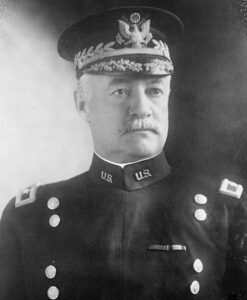 global influenza pandemic caused by the H1N1 influenza A virus. The pandemic affected an estimated 500 million people, or approximately a third of the global population. It is estimated that 17 to 50 million, and possibly as high as 100 million people lost their lives, which probably increased the deaths during the Meuse-Argonne offensive.
global influenza pandemic caused by the H1N1 influenza A virus. The pandemic affected an estimated 500 million people, or approximately a third of the global population. It is estimated that 17 to 50 million, and possibly as high as 100 million people lost their lives, which probably increased the deaths during the Meuse-Argonne offensive.
The Meuse–Argonne was the principal engagement of the American Expeditionary Force (AEF) during World War I, and it was what finally brought the war to an end. It was the largest and bloodiest operation of World War I for the AEF. Nevertheless, by October 31, the Americans had advanced 9.3 miles and had cleared the Argonne Forest. The French advanced 19 miles to the left of the Americans, reaching the Aisne River. The American forces split into two armies at this point. General Liggett led the First Army and advanced to the Carignan-Sedan-Mezieres Railroad. Lieutenant General Robert L Bullard led the Second Army and was directed to move eastward toward Metz. The two United States armies faced portions of 31 German divisions during this phase. The American troops captured German defenses at Buzancy, allowing French troops to cross the Aisne River. There, they rushed forward, capturing Le Chesne, also known as the Battle of Chesne (French: Bataille du Chesne).
In the final days, the French forces conquered the immediate objective, Sedan and its critical railroad hub in a 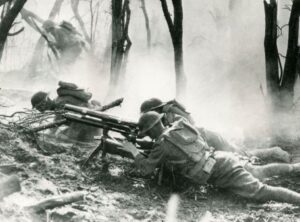
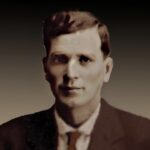
battle known as the Advance to the Meuse (French: Poussée vers la Meuse), and on November 6, American forces captured surrounding hills. On November 11, news of the German armistice put a sudden end to the fighting. That was fortunate for the armies, but for my 1st cousin twice removed, William Henry Davis, it was six days too late. He lost his life on November 5, 1918, on the west bank of the Meuse during these battles. He was just 30 years old at the time.
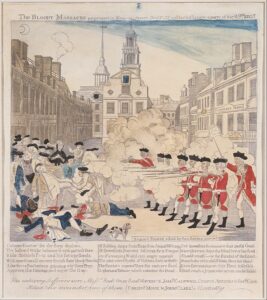 A mob of American colonists gathered at the Customs House in Boston, on the cold, snowy night of March 5, 1770. They called themselves Patriots, and they were there to protest the occupation of their city by British troops, who were sent to Boston in 1768 to enforce unpopular taxation measures passed by a British parliament that lacked American representation. I suppose it is possible that the colonists would have agreed to increase their taxes in an effort to help pay for the Seven-Year War, but the reality is that they were not asked…they were told, and it was to be forced upon them. They were not going tolerate that…so they would fight.
A mob of American colonists gathered at the Customs House in Boston, on the cold, snowy night of March 5, 1770. They called themselves Patriots, and they were there to protest the occupation of their city by British troops, who were sent to Boston in 1768 to enforce unpopular taxation measures passed by a British parliament that lacked American representation. I suppose it is possible that the colonists would have agreed to increase their taxes in an effort to help pay for the Seven-Year War, but the reality is that they were not asked…they were told, and it was to be forced upon them. They were not going tolerate that…so they would fight.
For their part, the British would also not be moved, and they were prepared to fight. British Captain Thomas Preston, the commanding officer at the Customs House, ordered his men to fix their bayonets and join the guard outside the building. The colonists…somewhat less prepared, responded by throwing snowballs and other objects at the British regulars. As the snowball fight commenced, Private Hugh Montgomery was hit, and not knowing what hit him, he discharged his rifle at the crowd. With that, the other soldiers began firing too, and when the smoke cleared, five colonists were dead or dying. They were Crispus Attucks, Patrick Carr, Samuel Gray, Samuel Maverick and James Caldwell. Three more were injured. Although it is unclear whether Crispus Attucks, an African American, was the first to fall as is commonly believed, the deaths of the five men are regarded by some historians as the first fatalities in the American Revolutionary War. After the massacre, the British soldiers were put on trial for war crimes. Strangely, patriots John Adams and Josiah Quincy agreed  to defend the soldiers in a show of support of the colonial justice system. When the trial ended in December 1770, two of the British soldiers were found guilty of manslaughter. As punishment, their thumbs were branded with an “M” for murder. In my mind, that is such a minor punishment, for what we view as such a major crime. I’m not sure if I think that any of the British soldiers were really guilty of murder, or even manslaughter, because it seems to me that in a moment of panic, the soldier mistakenly thought he was in eminent danger, when in reality, it was simply a snowball. Still, the punishment really didn’t fit the crime for which it was given.
to defend the soldiers in a show of support of the colonial justice system. When the trial ended in December 1770, two of the British soldiers were found guilty of manslaughter. As punishment, their thumbs were branded with an “M” for murder. In my mind, that is such a minor punishment, for what we view as such a major crime. I’m not sure if I think that any of the British soldiers were really guilty of murder, or even manslaughter, because it seems to me that in a moment of panic, the soldier mistakenly thought he was in eminent danger, when in reality, it was simply a snowball. Still, the punishment really didn’t fit the crime for which it was given.
The Stamp Act was called the “Boston Massacre” by the Sons of Liberty, a Patriot group formed in 1765 to oppose it. The “Boston Massacre” was viewed as a battle for American liberty and just cause for the removal of British troops from Boston. Patriot Paul Revere made an engraving of the incident, depicting the British soldiers lining up like an organized army to suppress an idealized representation of the colonist uprising. Copies of the engraving were distributed throughout the colonies. This was to help reinforce negative American sentiments about British rule. The colonists needed as many in their ranks to be onboard with the battle, and so any depiction of the British as cruel slave masters would help.
The American Revolution officially began in April of 1775, when British troops from Boston fought with American militiamen at the battles of Lexington and Concord. The British troops were under orders to capture 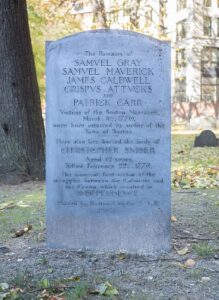 Patriot leaders Samuel Adams and John Hancock in Lexington and to confiscate the Patriot arsenal at Concord. Unfortunately for them, the Patriots were several steps ahead of them, and neither of the missions were accomplished because Paul Revere and William Dawes rode ahead of the British to warn Adams and Hancock and to rouse the Patriot minutemen.
Patriot leaders Samuel Adams and John Hancock in Lexington and to confiscate the Patriot arsenal at Concord. Unfortunately for them, the Patriots were several steps ahead of them, and neither of the missions were accomplished because Paul Revere and William Dawes rode ahead of the British to warn Adams and Hancock and to rouse the Patriot minutemen.
The British forces were forced to evacuate Boston eleven months later, in March 1776, following American General George Washington’s successful placement of fortifications and cannons on Dorchester Heights. Oddly the eight-year British occupation of Boston ended with a bloodless liberation of the city. General Washington, commander of the Continental Army, was presented with the first medal ever awarded by the Continental Congress for the victory. It would be more than five years before the Revolutionary War came to an end with British General Charles Cornwallis’ surrender to Washington at Yorktown, Virginia.
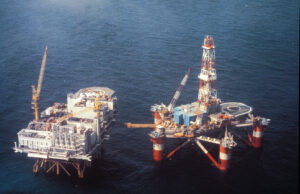 Apartment living is something many people do, and while they might dream of a house, or even have one, there can be reasons for having an apartment too. The oilfield would be one example of the need for a second place to live. Often, oil field workers must travel to the worksite. Once there, they have to stay there for a time, because traveling to and from home twice a day is just not feasible. Many oilfield companies provide living quarters for their employees. Sometimes it is a local motel, sometimes apartments, and sometimes, as with off shore drilling operations, companies must get innovative.
Apartment living is something many people do, and while they might dream of a house, or even have one, there can be reasons for having an apartment too. The oilfield would be one example of the need for a second place to live. Often, oil field workers must travel to the worksite. Once there, they have to stay there for a time, because traveling to and from home twice a day is just not feasible. Many oilfield companies provide living quarters for their employees. Sometimes it is a local motel, sometimes apartments, and sometimes, as with off shore drilling operations, companies must get innovative.
Some living quarters for oil field workers is quite a bit different than  others. The Edda oil rig in the Ekofisk field, 235 miles east of Dundee, Scotland had just such an unusual housing arrangement for the employees who worked on the Edda oil rig. The Alexander Kielland platform was a floating apartment unit that housed 208 people. The floating apartment complex was located in the North Sea. The majority of the Phillips Petroleum workers were from Norway, but a few were American and British. The platform was held up by two large pontoons. It had bedrooms, kitchens, and lounges, and provided a place for workers to spend their time when not working. It was truly a comfortable home away from home…for the most part.
others. The Edda oil rig in the Ekofisk field, 235 miles east of Dundee, Scotland had just such an unusual housing arrangement for the employees who worked on the Edda oil rig. The Alexander Kielland platform was a floating apartment unit that housed 208 people. The floating apartment complex was located in the North Sea. The majority of the Phillips Petroleum workers were from Norway, but a few were American and British. The platform was held up by two large pontoons. It had bedrooms, kitchens, and lounges, and provided a place for workers to spend their time when not working. It was truly a comfortable home away from home…for the most part.
On March 30, 1980, at about 6:30pm most of the residents were in the platform’s small theater watching a movie. There was a storm brewing, but although there were gale conditions in the North Sea that evening, no one was expecting that a large wave would collapse and capsize the platform. Everything happened very fast. 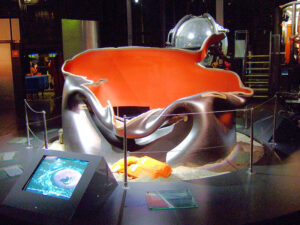 The wave hit, and things began to collapse. Within 15 minutes of the collapse, the floating apartment complex had capsized. It was so fast that many of the workers were unable to make it to the lifeboats. The Royal Air Force of Great Britain and Norwegian military both immediately sent rescue helicopters, but the poor weather made it impossible for them to help. Of the 208 people onboard, 123 drowned. The nightmare scenario seemed impossible, but a subsequent investigation revealed that there was a previously undetected crack in one of main legs of the platform. That had caused the structure’s disastrous collapse. The Alexander Kielland sat in the water for three years before it was salvaged.
The wave hit, and things began to collapse. Within 15 minutes of the collapse, the floating apartment complex had capsized. It was so fast that many of the workers were unable to make it to the lifeboats. The Royal Air Force of Great Britain and Norwegian military both immediately sent rescue helicopters, but the poor weather made it impossible for them to help. Of the 208 people onboard, 123 drowned. The nightmare scenario seemed impossible, but a subsequent investigation revealed that there was a previously undetected crack in one of main legs of the platform. That had caused the structure’s disastrous collapse. The Alexander Kielland sat in the water for three years before it was salvaged.
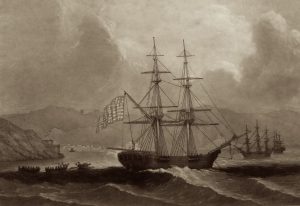 In 1799, in an area of the Caribbean Sea that had been listed as off limits for American ships, the English cutter, Sparrow intercepted the American brig, Nancy. The Nancy was in a place they should not have been, but the captain, Thomas Briggs produced papers claiming the ship was owned by a Dutchman. The captain of the Sparrow was skeptical, suspecting a smuggler. The problem was that he lacked evidence as to the true status of the Nancy, or the real reason for her trip. Due to his doubts about status and a lack of trust of the Nancy’s captain, the Sparrow’s captain sent Briggs to Jamaica to have his case heard by the vice-admiralty.
In 1799, in an area of the Caribbean Sea that had been listed as off limits for American ships, the English cutter, Sparrow intercepted the American brig, Nancy. The Nancy was in a place they should not have been, but the captain, Thomas Briggs produced papers claiming the ship was owned by a Dutchman. The captain of the Sparrow was skeptical, suspecting a smuggler. The problem was that he lacked evidence as to the true status of the Nancy, or the real reason for her trip. Due to his doubts about status and a lack of trust of the Nancy’s captain, the Sparrow’s captain sent Briggs to Jamaica to have his case heard by the vice-admiralty.
It turns out the captain of the Sparrow was not wrong in his doubts. Two days later, another English ship, the Ferret, caught a large shark near the coast of Haiti. When the cut the fish open, they found in its belly the papers of the American ship Nancy. Apparently, the Nancy’s captain, Thomas Briggs had thrown them overboard before getting false Dutch papers in Curacao. It was simply a fluke that the 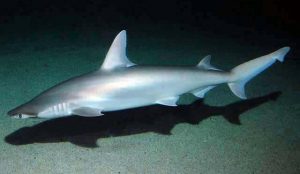 Ferret somehow managed to catch the very shark that ate the real papers. I suppose that if the Nancy’s captain had used any common sense at all, he would have burned the papers, and then thrown the ashes overboard. The likelihood of having any useable paperwork after they were burned, would be extremely slim. The valid papers for the Nancy were dubbed the “shark papers.” They were produced in court, and the Nancy and her cargo were confiscated.
Ferret somehow managed to catch the very shark that ate the real papers. I suppose that if the Nancy’s captain had used any common sense at all, he would have burned the papers, and then thrown the ashes overboard. The likelihood of having any useable paperwork after they were burned, would be extremely slim. The valid papers for the Nancy were dubbed the “shark papers.” They were produced in court, and the Nancy and her cargo were confiscated.
The Nancy truly was an American sailing vessel, even though the captain tried to hide that fact. It was a type of ship noted in sources as either a brig or a brigantine, and it had been chartered to transport war supplies during the American Revolutionary War. When Michael Fitton, captain of the schooner Ferret, tender to HMS Abergavenny, cruised the Mona Passage in company with Sparrow, commanded by Mr Whylie, the two accidentally separated for a few days. On rejoining, Fitton invited Whylie by signal to come to breakfast, and 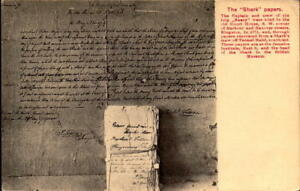 while waiting caught a large shark that was under the stern. In its stomach was a packet of papers relating to an American brig Nancy. When Whylie came on board, he mentioned that he had detained an American brig called Nancy. Fitton said that he had her papers. A shocked Whylie exclaimed, “Papers? Why, I sealed up her papers and sent them in with her.” “Just so, those were her false papers; here are her real ones,” replied Fitton. Proof positive. The fate of the Nancy and her captain were sealed. The shark’s jaws were set up on shore, with the inscription, “Lieutenant Fitton recommends these jaws for a collar for neutrals to swear through.” The papers are in the museum of the Royal United Service Institution.
while waiting caught a large shark that was under the stern. In its stomach was a packet of papers relating to an American brig Nancy. When Whylie came on board, he mentioned that he had detained an American brig called Nancy. Fitton said that he had her papers. A shocked Whylie exclaimed, “Papers? Why, I sealed up her papers and sent them in with her.” “Just so, those were her false papers; here are her real ones,” replied Fitton. Proof positive. The fate of the Nancy and her captain were sealed. The shark’s jaws were set up on shore, with the inscription, “Lieutenant Fitton recommends these jaws for a collar for neutrals to swear through.” The papers are in the museum of the Royal United Service Institution.
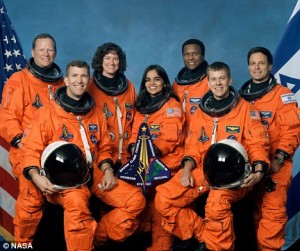
 Anyone who knows anything about the space program, knows about the disasters that have come out of it…or at least some of them. One of those disasters, the breakup of Space Shuttle Columbia, happened 18 years ago today, February 1, 2003. The breakup upon re-entry into Earth’s atmosphere took the lives of all seven astronauts on board, in a way that we can only imagine as horrific. The best we can hope for following the tragedy is that the astronauts were killed instantly, so they did not suffer in what followed the breakup. It was a horrible day for the United States, and for NASA, but what followed that terrible disaster was a truly remarkable phenomena.
Anyone who knows anything about the space program, knows about the disasters that have come out of it…or at least some of them. One of those disasters, the breakup of Space Shuttle Columbia, happened 18 years ago today, February 1, 2003. The breakup upon re-entry into Earth’s atmosphere took the lives of all seven astronauts on board, in a way that we can only imagine as horrific. The best we can hope for following the tragedy is that the astronauts were killed instantly, so they did not suffer in what followed the breakup. It was a horrible day for the United States, and for NASA, but what followed that terrible disaster was a truly remarkable phenomena.
It is tragedies like the Space Shuttle Columba that bring out the true American spirit. Feelings are set aside, and you suddenly see people hugging each other to comfort them. Columbia broke up in the skies of East Texas on its way back home to Kennedy Space Center. Almost immediately after losing the craft, the NASA world and many others, converged on the small town of Hemphill, Texas. Everyone wanted to help, and many who were not called into service, volunteered. The Space Program had become so commonplace and so routine that such an event came as a horrible shock to this nation and to the world. Suddenly we were glued to our television sets or radios, waiting for news, hoping against hope that there might be survivors, but knowing that it was clearly not possible.
It wasn’t just the NASA teams who showed up for this tragic event. Restaurants gave free meals to the workers. People reported anything they found so it could be documented and processed. The townspeople were there to offer comfort to those in need, because lets face it, these astronauts were members of the NASA family, and NASA (as well as the rest of the nation) was in mourning. As time went on, more and more searchers converged on Hemphill and the surrounding area. The local heroes continued to step up, giving any kind of support needed. This might seem like a small feat to some people, but this search went on for three months. That is a long time to care for so many in such a small town, but it was desperately needed, and 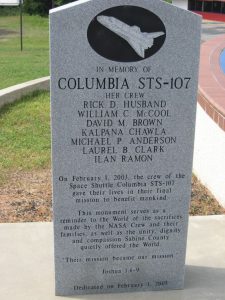
 gratefully received. After a long, drawn-out search, the teams had found all the seemed to be going to find, and almost as quickly as they had arrived, the teams were gone, and the small town of Hemphill, Texas was quiet again, but it would never be the same again. Three months in 2003 had changed it forever. The people who lived there in that time will never forget what they did back then, and we will never forget what they did. It was an awesome feat of kindness and love for our fellow man.
gratefully received. After a long, drawn-out search, the teams had found all the seemed to be going to find, and almost as quickly as they had arrived, the teams were gone, and the small town of Hemphill, Texas was quiet again, but it would never be the same again. Three months in 2003 had changed it forever. The people who lived there in that time will never forget what they did back then, and we will never forget what they did. It was an awesome feat of kindness and love for our fellow man.
 In a war, there are many heroes, and all too often, many of them are unsung heroes, who heroic acts all but go unnoticed. Lieutenant Colonel Matt Urban was one of those heroes, who actually became an Urban Legend, because of his uncanny ability to seemingly come back from the dead. Urban was one of the most decorated American officers of World War II. He fought in seven campaigns and was wounded seven times. Each time he was wounded, he seemingly came back to life…so often, in fact, that the Germans gave him the nickname “the Ghost.” When he was given the Medal of Honor, his citation referred to ten separate acts of bravery during the Normandy campaign alone.
In a war, there are many heroes, and all too often, many of them are unsung heroes, who heroic acts all but go unnoticed. Lieutenant Colonel Matt Urban was one of those heroes, who actually became an Urban Legend, because of his uncanny ability to seemingly come back from the dead. Urban was one of the most decorated American officers of World War II. He fought in seven campaigns and was wounded seven times. Each time he was wounded, he seemingly came back to life…so often, in fact, that the Germans gave him the nickname “the Ghost.” When he was given the Medal of Honor, his citation referred to ten separate acts of bravery during the Normandy campaign alone.
To name a few of the heroic and maybe just a little bit crazy acts of bravery, Urban took on multiple enemy tanks with a bazooka, all while walking on a cane because he’d broken his leg landing on Utah Beach. He organized multiple counterattacks after nearly having his leg blown off, then breaking himself out of the hospital, hitchhiking to the front, immediately throwing himself into battle, running into an abandoned tank and driving it toward the enemy line with no crew!! He was wounded again and again, but refused to be evacuated. Finally, a bullet in the throat took him out of combat for good. His reign of terror  against the Germans was over, but not his life. Once again, the Germans couldn’t kill “the Ghost.” Urban recovered, survived the war, and lived until 1995. Urban died on March 4, 1995, in Holland, Michigan, at the age of 75. The cause of death was a collapsed lung, reportedly due to his war injuries. He is buried in Plot: Section 7a, Grave 40 at Arlington National Cemetery in Arlington, Virginia.
against the Germans was over, but not his life. Once again, the Germans couldn’t kill “the Ghost.” Urban recovered, survived the war, and lived until 1995. Urban died on March 4, 1995, in Holland, Michigan, at the age of 75. The cause of death was a collapsed lung, reportedly due to his war injuries. He is buried in Plot: Section 7a, Grave 40 at Arlington National Cemetery in Arlington, Virginia.
“Matt Louis Urban was a highly decorated United States Army combat soldier who served with distinction as an infantry officer in the Mediterranean and European Theater of Operations during World War II. He scouted, led charges upfront, and performed heroically in combat on several occasions despite being wounded. He retired after World War II as a lieutenant colonel. Urban received over a dozen individual decorations for combat from the U.S. Army, including seven Purple Hearts. In 1980, he received the Medal of Honor and four other individual decorations for combat belatedly for his actions in France and Belgium in 1944. In Section 7a of the “Prominent Military Figures”
Matt Urban was born Matthew Louis Urbanowicz in Buffalo, New York, to Polish immigrant Stanley Urbanowicz,  a plumbing contractor. His mother Helen was born in Depew, New York. He attended East High School in Buffalo, and graduated in 1937. Urban had three brothers: Doctor Stanley (Urbanowicz) Urban, Arthur (Urbanowicz) Urban, and Eugene, who died in 1927 from appendicitis. In the fall of 1937, he enrolled at Cornell University in Ithaca, New York, majoring in history and government with a minor in community recreation. He graduated on June 14, 1941, with a Bachelor of Arts degree. For reasons unknown, he used the name Matty L. Urbanowitz during his last year of college. While at Cornell University, he was a member of the Reserve Officers Training Corps (ROTC), the track and boxing teams, and the Kappa Delta Rho fraternity. Nevertheless, his greatest accomplishment was that of the Urban Legend known as “the Ghost.”
a plumbing contractor. His mother Helen was born in Depew, New York. He attended East High School in Buffalo, and graduated in 1937. Urban had three brothers: Doctor Stanley (Urbanowicz) Urban, Arthur (Urbanowicz) Urban, and Eugene, who died in 1927 from appendicitis. In the fall of 1937, he enrolled at Cornell University in Ithaca, New York, majoring in history and government with a minor in community recreation. He graduated on June 14, 1941, with a Bachelor of Arts degree. For reasons unknown, he used the name Matty L. Urbanowitz during his last year of college. While at Cornell University, he was a member of the Reserve Officers Training Corps (ROTC), the track and boxing teams, and the Kappa Delta Rho fraternity. Nevertheless, his greatest accomplishment was that of the Urban Legend known as “the Ghost.”

